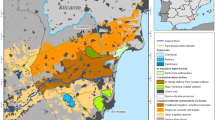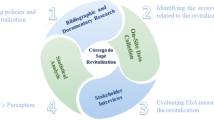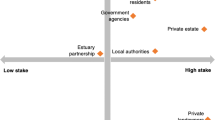Abstract
Negative impacts of environmental degradation and climate change are exacerbated when they co-occur in a single region, threatening people's way of life. In addition, historical and territorial processes generate a complex mosaic of interactions of residents and nonresidents, with a wide diversity of livelihoods. This generates a series of social, environmental and political conflicts in the territory. These conflicts have triggered an accelerated process of degradation, overexploitation and pressure on the Lacustrine Zone of Xochimilco (LZX). Therefore, research on how people’s opinions and perceptions into decisions could help to generate a baseline for further collaboration. We documented the perceptions of nonresidents that are involved in decision making in the LZX in terms of degradation and climate change impacts and their opinions on the actions that could help strengthen the resilience of this area. According to our results, environment and culture were the most relevant features of the LZX, while social and institutional features were the most problematic ones. Additionally, nonresident actors emphasized the tendency of the LZX to collapse, which could become even more likely due to the impacts of climate change. To address these problems, restoring the “chinampa” type of production and implementing alternative tourism were the most frequently proposed actions, while training, involving stakeholders, and strengthening governance were the most frequently proposed strategies.




Similar content being viewed by others
Change history
26 June 2020
A Correction to this paper has been published: https://doi.org/10.1007/s10668-020-00823-w
References
Abascal, E., & Grande, I. (2014). Análisis de Encuestas. Igarss, 2014(1), 1–5.
Adamson, G. C. D., Hannaford, M. J., & Rohland, E. J. (2018). Re-thinking the present: The role of a historical focus in climate change adaptation research. Global Environmental Change, 48, 195–205. https://doi.org/10.1016/j.gloenvcha.2017.12.003.
Alatriste Guzmán, O. (2005). Xochimilco. Aspectos histórico-culturales. Boletín CEPE UNAM.
Campos, C. J. G., & Turato, E. R. (2009). Análisis de contenido en investigaciones que utilizan la metodología clínico-cualitativa: aplicación y perspectivas. Revista Latino-Americana de Enfermagem, 17(2), 259–264.
Castelán Crespo, E., & Leautaud Valenzuela, P. (2016). Suelo de Conservación, 1st edn. Ciudad de México.
Cid, A., Cano, D., Montalvo, V., Ruíz-Bedolla, K., Romero-Cazares, M., Monterroso-Rivas, A. I., et al. (2020). Insights for building institutional capacities for climate change adaptation: evidence from Mexico. In F. W. Leal (Ed.), Handbook of climate change management. Berlin: Springer.
Coe, M. D. (1964). The Chinampas of Mexico. Scientific American, 211(1), 90–98. https://doi.org/10.1038/scientificamerican0764-90.
Conway, R. (2012). Lakes, Canoes, and the aquatic communities of Xochimilco and Chalco, New Spain. Ethnohistory, 59(3), 541–568. https://doi.org/10.1215/00141801-1587460.
Dannevig, H., Rauken, T., & Hovelsrud, G. (2012). Implementing adaptation to climate change at the local level. Local Environment, 17(6–7), 597–611.
Davoudi, S., Brooks, E., & Mehmood, A. (2013). Evolutionary resilience and strategies for climate adaptation. Planning Practice and Research, 28(3), 307–322. https://doi.org/10.1080/02697459.2013.787695.
de los Quiñonez Amezquita, C. T. M. (2005). Chinampas y chinamperos: Los horticultores de San Juan Tezompa. Mexico City: Universidad Iberoamericana.
Destination wetlands: supporting sustainable tourism. (2012). Secretariat of the Ramsar Convention on Wetlands, Gland, Switzerland, & World Tourism Organization (UNWTO), Madrid, Spain.
DOF. (2013). Estrategia nacional de cambio climático. Diario Oficial de la Federación.
Espejel, B. O., Bando, U., Aguirre, J. L. V., Herrera, M. A., Frich, B. A., & Guzmán, M. A. E. (2009). La construcción social del cambio climático: Fortalecimiento de las capacidades institucionales en México. Foro de Investigación 2009: reporte de avances de proyectos, p. 92.
Estrada Porrua, F., Martinez-Arroyo, A., Fernández-Eguiarte, A., Luyando, E., & Gay, C. (2009). Defining climate zones in Mexico City using multivariate analysis. Atmósfera, 22(2), 175–193.
Gilly, J.-P., Kechidi, M., & Talbot, D. (2014). Resilience of organisations and territories: The role of pivot firms. European Management Journal, 32(4), 596–602. https://doi.org/10.1016/j.emj.2013.09.004.
GODF. D. (2006b). Decreto por el cual se modifica el polígono del área natural protegida, con carácter de zona sujeta a conservación ecológica, la superficie denominada “Ejidos de Xochimilco y San Gregorio Atlapulco” ubicada en la delegación Xochimilco del Distrito Federal. Gaceta Oficial del Distrito Federal, pp. 48–106.
GODF, D. (2012). Decreto por el que secrea la Autoridad de la Zona Patrimonio Mundial Natural y Cultural de la Humanidad en Xochimilco, Tláhuac y Milpa Alta, como un órgano de apoyo a las actividades de la Jefatura de Gobierno en las Delegaciones Xochimilco, Tláhuac y Mil. Gaceta Oficial del Distrito Federal. http://www.ordenjuridico.gob.mx/Documentos/Estatal/DistritoFederal/wo76119.pdf. Accessed 17 Nov 2018.
GODF, J. (2006a). Acuerdo por el que se aprueba el programa de manejo del Área Natural Protegida con carácter de Zona de Conservación Ecológica “Ejidos de Xochimilco y San Gregorio Atlapulco. Gaceta Oficial del Distrito Federal, pp. 2–41. http://www.paot.org.mx/transparencia/doc/2011/segundo_trimestre/Reglas_sistema_integral_2011.pdf. Accessed 20 Nov 2018.
Gómez, M. (2000). Análisis de contenido cualitativo y cuantitativo: Definición, clasificación y metodología. Revista de Ciencias Humanas, 20, 103–113.
Hayes, N. (2013). Doing qualitative analysis in psychology. Hove: Psychology Press.
Hernández Sampieri, R., Fernández Collado, C., & Baptista Lucio, P. (2010). Metodología de la investigación. México: McGraw-Hill.
Hovelsrud, G. K., & Smit, B. (2010). Community adaptation and vulnerability in Arctic regions. Berlin: Springer.
Jiménez, M., Pérez-Belmont, P., Schewenius, M., Lerner, A. M., & Mazari-Hiriart, M. (2020). Assessing the historical adaptive cycles of an urban social-ecological system and its potential future resilience: the case of Xochimilco, Mexico City. Regional Environmental Change, 20(1), 7.
Kiker, G. A., Bridges, T. S., Varghese, A., Seager, T. P., & Linkov, I. (2005). Application of multicriteria decision analysis in environmental decision making. Integrated Environmental Assessment and Management, 1(2), 95. https://doi.org/10.1897/IEAM_2004a-015.1.
Lamara, H. (2009). Les deux piliers de la construction territoriale: Coordination des acteurs et ressources territoriales. Développement Durable et Territoires. https://doi.org/10.4000/developpementdurable.8208.
Laurance, W. F. (2007). Forest-climate interactions in fragmented tropical landscapes. In Y. Malhi & O. L. Phillips (Eds.), Tropical forests and global atmospheric change. Oxford: Oxford University Press.
Laurance, W. F., & Williamson, G. B. (2001). Positive feedbacks among forest fragmentation, drought, and climate change in the Amazon. Conservation Biology, 15(6), 1529–1535. https://doi.org/10.1046/j.1523-1739.2001.01093.x.
Manzo, R. F., & López-Ornelas, G. (2010). Conformación de la agroindustria del amaranto en Santiago Tulyehualco, Xochimilco, México. Elementos que han permitido la transformación productiva y social en las familias rurales.
Martínez Ruiz, J. L. (2014). The chinampa: a sustainable high efficient agrohydrologic system for shallow lacustrine and wetland areas. Water Practice and Technology, 9(3), 324–330. https://doi.org/10.2166/wpt.2014.034.
Mehmood, A. (2016). Of resilient places: planning for urban resilience. European Planning Studies, 24(2), 407–419. https://doi.org/10.1080/09654313.2015.1082980.
Melgarejo, L. M. V. (1994). Sobre el concepto de percepción. Alteridades, 8, 47–53.
Moulaert, F., & Nussbaumer, J. (2005). The social region. European Urban and Regional Studies, 12(1), 45–64. https://doi.org/10.1177/0969776405048500.
Munang, R., Thiaw, I., Alverson, K., Mumba, M., Liu, J., & Rivington, M. (2013). Climate change and ecosystem-based adaptation: A new pragmatic approach to buffering climate change impacts. Current Opinion in Environmental Sustainability, 5(1), 67–71. https://doi.org/10.1016/j.cosust.2012.12.001.
Narchi, N. E. (2013). Deterioro ambiental en Xochimilco: Lecciones para el cambio climático global. Veredas Revista del Pensamiento Sociológico, 27, 177–197.
Narchi, N. E., & Canabal Cristiani, B. C. (2016). Percepciones de la degradación ambiental entre vecinos y chinamperos del Lago de Xochimilco, México. Sociedad y Ambiente, 12, 5–29.
Narchi, N. E., & Cristiani, B. C. (2015). Subtle tyranny. Latin American Perspectives, 42(5), 90–108. https://doi.org/10.1177/0094582X15585118.
Navarrete, S., Jiménez, B., Navarro, I., & Domínguez, R. (2013). Evaluación del riesgo al acuífero de Xochimilco por lluvias extremas. Tecnología y Ciencias del Agua, 4(3), 103–123.
O’Brien, K., Eriksen, S., Sygna, L., & Naess, L. O. (2006). Questioning complacency: Climate change impacts, vulnerability, and adaptation in Norway. AMBIO: A Journal of the Human Environment, 35(2), 50–56.
PAOT. (2010). Estudio espacio-temporal del uso del suelo en el área localizada entre el trazo de la Línea 12 del metro y el sitio Ramsar 1363. http://centro.paot.org.mx/documentos/paot/estudios/Estudio_RAMSAR_2010.pdf.
Pimienta Lastra, R. (2000). Encuestas probabilísticas vs. no probabilísticas. Política y Cultura, 13, 263–276.
PNUD México & INECC. (2017). Medición multidimensional de capacidad institucional a nivel municipal que fomente la adaptación al cambio climático. Informe Final. Proyecto #86487 “Plataforma de Colaboración sobre Cambio Climático y Crecimiento Verde entre Canadá y México.” Ciudad de México.
Pontifes, P. A., García-Meneses, P. M., Gómez-Aíza, L., Monterroso-Rivas, A. I., & Caso-Chávez, M. (2018). Land use/land cover change and extreme climatic events in the arid and semi-arid ecoregions of Mexico. Atmósfera, 31(4), 355–372. https://doi.org/10.20937/ATM.2018.31.04.04.
Retamal, M. R., Rojas, J., & Parra, O. (2011). Percepción al cambio climático y a la gestión del agua: Aportes de las estrategias metodológicas cualitativas para su comprensión. Ambiente and Sociedade, 14(1), 175–194. https://doi.org/10.1590/S1414-753X2011000100010.
Revollo-Fernández, D. A. (2015). Economic value and historical scenic beauty: The case of Chinampas (Raised Beds) in Xochimilco, UNESCO World Heritage Site, Mexico. Natural Resources, 06(04), 273–285. https://doi.org/10.4236/nr.2015.64024.
Rizzi, P., Graziano, P., & Dallara, A. (2018). A capacity approach to territorial resilience: The case of European regions. The Annals of Regional Science, 60(2), 285–328. https://doi.org/10.1007/s00168-017-0854-1.
Rodríguez, I., & Landázuri Benítez, G. (2005). Fortalecer el patrimonio y la identidad turistificándolos? El caso de San Gregorio Atlapulco, Xochimilco. Revista de Arquitectura, Urbanismo y Territorios, 1, 345–360.
Romero Lankao, P. (2010). Water in Mexico City: What will climate change bring to its history of water-related hazards and vulnerabilities? Environment and Urbanization, 22(1), 157–178. https://doi.org/10.1177/0956247809362636.
Rosas, I., Salinas, E., Martínez, L., Cruz-Córdova, A., González-Pedrajo, B., Espinosa, N., et al. (2015). Characterization of Escherichia coli isolates from an urban lake receiving water from a wastewater treatment plant in Mexico City: Fecal pollution and antibiotic resistance. Current Microbiology, 71(4), 490–495. https://doi.org/10.1007/s00284-015-0877-8.
Ruiz Gutiérrez, E. (2012). El patrimonio cultural y ambiental de Xochimilco en riesgo.
Salgado Lévano, A. C. (2007). Investigación cualitativa: Diseños, evaluación del rigor metodológico y retos. Liberabit, 13(13), 71–78.
Salles, V. (1992). Xochimilco: perdurabilidad de la tradición en un contexto de cambio. Estudios Sociológicos, 10, 341–362.
Sanchez-Zamora, P., Gallardo-Cobos, R., & Ceña-Delgado, F. (2014). El medio rural andaluz frente a la crisis económica: Un análisis de los factores de resiliencia territorial. Economia Agraria y Recursos Naturales, 14(1), 27–56. https://doi.org/10.7201/earn.2014.01.02.
Selman, P. (2009). Planning for landscape multifunctionality. Sustainability: Science, Practice and Policy, 5(2), 45–52. https://doi.org/10.1080/15487733.2009.11908035.
Simmie, J., & Martin, R. (2010). The economic resilience of regions: Towards an evolutionary approach. Cambridge Journal of Regions, Economy and Society, 3(1), 27–43. https://doi.org/10.1093/cjres/rsp029.
Torres-Lima, P., Conway-Gómez, K., & Buentello-Sánchez, R. (2018). Socio-environmental perception of an urban wetland and sustainability scenarios: a case study in Mexico City. Wetlands, 38(1), 169–181. https://doi.org/10.1007/s13157-017-0967-4.
UNESCO. (2006). Xochimilco, Tláhuac, Milpa Alta. Resumen del plan integral y estructura de gestión del polígono de Xochimilco, Tláhuac y Milpa Alta, inscrito en la lista del patrimonio mundial de la UNESCO. http://arquitectura.unam.mx/uploads/8/1/1/0/8110907/plan_maestro_unesco_xochimilco.pdf.
Waldhardt, R., Bach, M., Borresch, R., Breuer, L., Diekötter, T., Frede, H.-G., et al. (2010). Evaluating today’s landscape multifunctionality and providing an alternative future: A normative scenario approach. Ecology and Society, 15(3), art30. https://doi.org/10.5751/ES-03590-150330.
Webb, N. P., Marshall, N. A., Stringer, L. C., Reed, M. S., Chappell, A., & Herrick, J. E. (2017). Land degradation and climate change: building climate resilience in agriculture. Frontiers in Ecology and the Environment, 15(8), 450–459. https://doi.org/10.1002/fee.1530.
Wigle, J. (2010). The “Xochimilco model” for managing irregular settlements in conservation land in Mexico City. Cities, 27(5), 337–347. https://doi.org/10.1016/j.cities.2010.04.003.
Wigle, J. (2014). The ‘Graying’ of ‘Green’ Zones: Spatial Governance and Irregular Settlement in Xochimilco, Mexico City. International Journal of Urban and Regional Research, 38(2), 573–589. https://doi.org/10.1111/1468-2427.12019.
Zambrano, L., Rivas, M. I., Uriel-Sumano, C., Rojas-Villaseñor, R., Rubio, M., Mena, H., et al. (2020). Adapting wetland restoration practices in urban areas: Perspectives from Xochimilco in Mexico City. Ecological Restoration, 38(2), 114–123.
Acknowledgements
This research would not have been possible without the collaboration of each actor who answered the questionnaire and those who participated in the pilot test. We thank Cecilia Conde and Margarita Caso Chávez for the institutional (INECC) support. We also thank Pilar Balderas and M. Alicia del Carmen Lombardero Goldaracena, who facilitated contact with these key actors. The statistical analyzes were supported by María Regina Arroyo, whom we deeply appreciate her participation.
Author information
Authors and Affiliations
Corresponding author
Additional information
Publisher's Note
Springer Nature remains neutral with regard to jurisdictional claims in published maps and institutional affiliations.
Electronic supplementary material
Below is the link to the electronic supplementary material.
Rights and permissions
About this article
Cite this article
Gómez Aíza, L., Ruíz Bedolla, K., Low-Pfeng, A.M. et al. Perceptions and sustainable actions under land degradation and climate change: the case of a remnant wetland in Mexico City. Environ Dev Sustain 23, 4984–5003 (2021). https://doi.org/10.1007/s10668-020-00800-3
Received:
Accepted:
Published:
Issue Date:
DOI: https://doi.org/10.1007/s10668-020-00800-3




